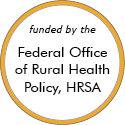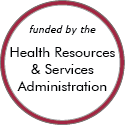Rural Project Examples: Children and youth
Promising Examples
Contingency Management Smoking Cessation in Appalachia
Updated/reviewed June 2022
- Need: To reduce smoking rates of pregnant women and adolescents in Appalachian regions of eastern Kentucky and Ohio.
- Intervention: A web-based smoking cessation program that offered monetary incentives to reducing smoking.
- Results: Participants significantly reduced smoking rates or quit altogether.
School-Based Health Center Dental Outreach

Updated/reviewed July 2020
- Need: To improve the oral health status of children ages 3 to 17 living in underserved rural areas of Louisiana.
- Intervention: School-based nurse practitioners perform oral health assessments, apply fluoride varnishes when indicated, and make dental referrals, with completion rates of the latter tracked by dental case managers.
- Results: Significant numbers of school children are receiving oral health examinations, fluoride varnish applications, and receiving care coordination to improve numbers of completed dental appointments.
Youth4Health

Updated/reviewed December 2019
- Need: To educate youth about obesity and healthy lifestyle choices.
- Intervention: An educational program about healthy living was implemented in Lincoln and Claiborne Parishes in Louisiana for youth ages 9-18.
- Results: Youth4Health program produced greater awareness and participation in healthier lifestyles by target youth and their families, as well as church congregations.
Other Project Examples
Jana's Campaign: Secondary Education Prevention Programming
Updated/reviewed March 2024
- Need: To reduce teen dating violence in middle schools, high schools, and youth organizations by promoting healthy relationship behaviors and fostering a culture of respect among adolescents.
- Intervention: Jana's Campaign offers prevention programs, including curricular and co-curricular activities, to highlight the 'red flags' and underlying causes of unhealthy dating relationships.
- Results: Since 2013, 661 middle and high schools and more than 92,673 students in Kansas, Nebraska, Colorado, Missouri, Oklahoma, Texas, Oregon, Montana, and Washington State have benefited from these programs.
Project ACTIVATE (Advancing Coordinated and Timely InterVentions, Awareness, Training, and Education)
Updated/reviewed February 2024
- Need: To improve students' access to behavioral health services in rural North Carolina.
- Intervention: North Carolina Project ACTIVATE provides three tiers of behavioral health supports in the school setting.
- Results: The six pilot sites (Cohorts 1 and 2) have created or revised 91 mental health policies, and 40,572 school-based and related employees have received training in different topics and protocols.
Mother's Milk Bank of South Carolina
Updated/reviewed January 2024
- Need: Neonatal Intensive Care Units (NICUs) across the state of South Carolina were purchasing breast milk from out-of-state milk banks for preterm infants.
- Intervention: The Mother's Milk Bank of South Carolina (MMBSC) opened 26 sites in South Carolina for breast milk to be donated, safely pasteurized, and delivered to NICUs across the state.
- Results: Over 19,178,739 ounces of milk have been donated to MMBSC depot sites and over 13,830,600 ounces of milk have been delivered to South Carolina NICUs.
Cold Water Safety Children and Youth Educator Program

Updated/reviewed December 2023
- Need: Drowning was a leading cause of death for children in Alaska.
- Intervention: Cold Water Safety and Survival for Educators workshops were developed in 1998, with help from a 4-year federal grant, to train educators to provide education and hands-on skills for school children and members of the public.
- Results: The safety program was integrated into about 50% of Alaskan school curriculum and schools in other states, helping to train hundreds of educators and thousands of children on the importance of cold water safety.
Schoharie County ACEs Team
Updated/reviewed December 2023
- Need: Agencies in Schoharie County, New York were seeing a widespread trend of Adverse Childhood Experiences (ACEs) in the children and families they served.
- Intervention: The Schoharie ACEs Team was formed as a way to educate rural communities about ACEs, the associated brain science, and ways to build resiliency.
- Results: The ACEs Team has put on 5 half-day educational conferences, 2 virtual conferences, and 10 trainings for various groups across the region. The team has also trained 3 school districts on trauma-informed care and provided resources for families exposed to trauma.
Tea Time with Teens
Updated/reviewed December 2023
- Need: To develop teen leaders, build self-confidence, and lower teen pregnancy rates in Marlboro County, South Carolina.
- Intervention: Tea Time with Teens brings together community leaders, mothers, and daughters to build life skills and make healthy decisions. In addition, the program sponsors a middle school club and has an extension program for young women.
- Results: Since 2009, the program has been educating teens on making healthy choices and adults on having meaningful conversations with teens.
Cavity Free at Three

Updated/reviewed October 2023
- Need: In Colorado, 31% of children have experienced dental decay by the time they reach kindergarten. With several frontier and rural counties in Colorado considered Dental Care Health Professional Shortage Areas (HPSAs), options for oral healthcare are limited.
- Intervention: Cavity Free at Three (CF3) works to improve access to preventive oral health for pregnant women and young children.
- Results: CF3 has trained over 6,000 medical and dental professionals in performing preventive dental health. The percentage of children who received oral healthcare from a medical or dental provider before the age of 2 has progressively increased, and Colorado saw reduced cavities starting in 2007.
For examples from other sources, see:
